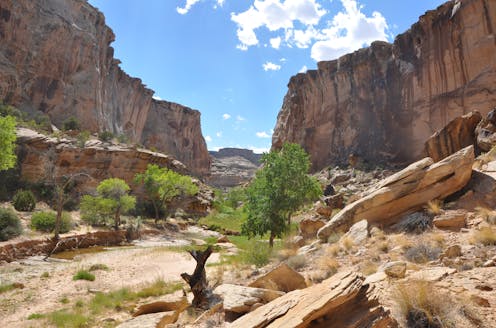
Environment + Energy – Articles, Analysis, Opinion
Displaying 1026 - 1050 of 2389 articles

PFAS chemicals are toxic, widespread and persistent in the environment, and the federal government has been slow to regulate them. A scientist explains why evaluating them one by one isn’t working.

Similar arrangements already support the National Park Service, the National Institutes of Health and other federal agencies.

Republicans and Democrats take sharply different positions on managing US public lands, but there’s solid consensus on some issues.

Conservation or copper? A proposed mine in northern Minnesota pits industrial jobs against a thriving outdoor economy.

Greenland’s glaciers have retreated so far that they can no longer support the ice sheet that feeds them. The ice sheet system has reached a new normal of consistent annual ice loss.

A team of researchers found the southernmost tree and forest on Earth at the extreme tip of South America. Wind limits where trees grow on Isla Hornos and those wind patterns are shifting.

Extreme shrinkage of summer sea ice is just the latest evidence of rapid Arctic warming – and what happens in the Arctic doesn’t stay there.

New risk models show nearly twice as many properties are at risk from a 100-year flood today than the government’s flood maps indicate.

Life in captivity causes observable harm to the structure and function of large mammals’ brains.

Hurricane stalling has become common over the past half-century, and their average forward speed has also slowed.

The pandemic recession has reduced US energy demand, roiling budgets in states that are major fossil fuel producers. But politics and culture can impede efforts to look beyond oil, gas and coal.

It’s only happened twice since naming started in 1950, and there’s an unusual twist to where many of the storms formed this year.

Wildfires aren’t always wild. Many of the most expensive and damaging fires happen in suburban areas, and nearly all blazes in these zones are started by humans.

Can a plan that brings together government and private landowners create enough habitat for monarch butterflies?

Two environmental engineers say governments need to do more to protect people from possible water contamination after wildfires.

Debating whether climate change or forest management has caused the devastating wildfires in California, Washington and Oregon is a false choice.

Hurricane Harvey destroyed the fishing infrastructure of Aransas Bay and reduced fishing by 80% over the following year. This removed humans from the trophic cascade and whole food webs changed.

How destructive storm surge gets depends on both the hurricane and the shape of the land.

For decades, scientists believed that only male birds sang. Then women entered the field and showed what their predecessors had missed.

How climate change and other human actions have combined to create conditions for explosive wildfires in California, Oregon and Washington state.

When water stagnates in pipes, harmful metals and bacteria can accumulate and make people sick. Buildings that were shut down for weeks during the pandemic may be at risk.

A new plan targets areas around the world that can store carbon and protect large numbers of species. It calls for preserving these lands, working with Indigenous peoples and connecting wild areas.

US ideas about conservation center on walling off land from use. That approach often means expelling Indigenous and other poor people who may be its most effective caretakers.

The Trump administration is rolling back a regulation that requires showerheads to conserve water, which saved owners an average of US$70 and nearly 3,000 gallons of water yearly per showerhead.

Endocrine-disrupting compounds are pervasive in modern life, from food packaging to shampoo. Research is connecting their effects on humans to risk of severe illness or death from the coronavirus.
